The scope is wide ... anything of interest to Circlist readers is welcome here. Textbooks, novels, photobooks, documentary and fictional movies. All submissions are welcome but please note that we do need full information - author, publisher, date, pages, ISBN and price for books; director, producer, principal actors, studio and duration for movies. Send your reviews to editor@circlist.com. So here we go ....
Der Schnitt (The Cut) by Lukas Stoermer
elbaol verlag Hamburg, 2011, 189 pages ISBN: 978-3-939771-05-0, price €14.95 (in German)
This novel is about a theme that one is reluctant to speak about: the circumcision of boys. And at the same time a great story is told. . .
Manuel is failing at school and needs to be sent to a boarding school. In his frustration, he feigns an abduction and takes off. But he does not get far. His bad conscience brings him in and he returns. This is followed by the first days at the boarding school. And this includes the health check. Poor Manuel is informed of the diagnosis "foreskin constriction"! He does not even know what will happen to him when he has to have a small surgery in the hospital: circumcision. When he wakes, everything is different. His foreskin was completely cut off. And Manuel suddenly feels that an important part of him is missing. From this day he feels different - somehow both not ashamed and ashamed. And this feeling will still have a meaning for him in many situations. In a captivating way, Manuel's life is told: from the special friendship to his new and soon best friend David. From the first erotic encounters with girls and also from human disappointments. . .
Review by "Dr. Sommer" from Bravo, the German teen magazine, translated by Dr. Google and the editor. You can read the original review here. The book carries the byline "Eine Ermutigung für Jungen, selbst über ihren Körper zu bestimmen! Denn eine Vorhaut ist keine Krankheit!" (An encouragement for boys to decide for themselves about their body! For a foreskin is not a disease!). Could one hope for an English translation?
The Cider House Rules by John Irving
Ballantine Books, 1999, 587 pages (first published by William Morrow, 1985) ISBN: 9780062235183
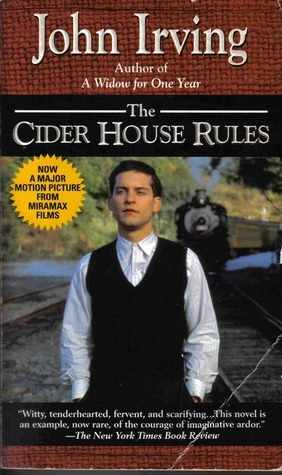
This is not a full-blown review of the book, but covers the passages relating to circumcision.
The first part of the story is set in a Maine state orphanage run by Dr. Wilbur Larch. Most of the children come from women who bear them but are unable or unwilling to keep them. The goal of the orphanage is to have them adopted. Dr. Larch also secretly does illegal but medically competent abortions for women who choose to end their pregnancies that way.
Early in the book it is stated that all the boys born at the orphanage are circumcised. Dr. Larch is a strong believer in circumcision as a result of his service in World War I. There he had to treat many soldiers suffering from penile problems caused by poor field sanitation and by sexually transmitted diseases.
One boy, Homer Wells, is never successfully adoped and becomes a permanent ward of the orphanage. Dr. Larch, a single man, trains Homer to be his assistant in obstetrics and treats him like a son, intending for him to have a career in medicine. When Homer is a teenager a teenage couple, Wally and Candy, come to the orphanage for Candy to have an abortion. Homer decides he wants to see more of the world beyond the orphanage. He departs with Wally and Candy and takes up residence in Wally's family home on an apple farm.
The second mention of circumcision comes as the three of them are traveling together. They stop in a town where Homer facetiously suggests they visit a certain boy who was adopted from the orphanage. Homer tells them he circumcised the boy. This contributes to the story by showing Wally and Candy that although Homer is their age he has had vastly different experiences in his young life.
World War II begins. Wally joins the Air Force and becomes a pilot. Homer is exempt from the draft because Dr. Larch fabricated a medical disqualification for him. Wally's plane is shot down over Burma and he is presumed dead. Homer and Candy begin a romantic relationship that leads to her becoming pregnant. Before anyone else is aware of the situation they travel to the orphanage, saying that they are going to do volunteer work there as their contribution to the war effort. They remain there until their son Angel is born.
Dr. Larch insists that Homer do Angel's circumcision. What this contributes to the story is to strengthen the bond between Homer and Angel, and also to satisfy Dr. Larch that Homer is maintaining his surgical skills. Dr. Larch still wants Homer to be his successor, while Homer is not at all convinced that a career in medicine is what he wants. Homer and Candy return to the apple farm with Angel, not revealing his actual parentage but telling everyone that Homer decided to adopt him.
That's the end of the circumcision related material. Wally turns up alive but severely injured, and things get very complicated after that. You'll have to read the book - or one of the more complete reviews - to learn how it all turns out.
JH
The Hand-Reared Boy, by Brian W. Aldiss
London, Weidenfeld & Nicholson, 1970 / Corgi Books 1971. ISBN 0 552 08699 1 142pp

The beautiful setting of Framlingham College, the English Public School where Brian Aldiss was educated.
Any resemblance to 'Branwells' may or may not be coincidental.
Horatio Stubbs is a bank-manager's son, and like most young boys very interested in his penis.
He and his older brother Nelson are both circumcised, but he soon discovers that some of the other boys are different. "Roaming through the fields with a couple of my pals one day, and stopping for a pee, I saw that one of them had the other kind of prick, with skin. When we were alone I asked him to let me have a look at it.
He brought it out willingly. It seemed a very strange object, somewhat long and pale, with the skin coming right over the red knob and ending pink and pursed almost like the bud of a small flower. He let me finger it. When I rubbed it a bit for him, nothing happened. I believe I asked him if it would open and he said no."
Another boy called William provided more enlightenment: "His penis felt pulpy and peculiar, and was covered by a very thick skin, which I touched. It became erect in my grasp and he let me draw the skin back, to reveal his glistening knob brightly coloured." a later encounter ... "I had the notion, before his grew too large, of inserting my knob under his foreskin. In this unusual position we proceeded to wank ourselves off. It excited me as much as it did William. Eventually he broke loose, rubbing himself briskly and crying 'Here it comes!' I was mystified, and not unmoved, by my first glimpse of anyone undergoing orgasm."
Boarding school, "Branwells", brought greater enlightenment, including eventually an understanding of the social issues which, in 1930s England, determined why some boys would be circumcised and others not. Mutual masturbation was quite ritualised:
'Insurance' clubs also flourished. In my second term I was voted into such a club in our corner of the dormitory. My bed was the penultimate along one end of a line of beds; the chap in the end bed, I, and the next two along, formed a club of four. We took it in turn each night to creep out of bed and toss off each of the others; we could do ourselves simultaneously, or let the others help, but the rota had to be filled each night. Neither wanker nor wanked was allowed to back out of his duty under any pretext, unless he was playing in a house or school game next day, in which case he was allowed to conserve his strength.Not all encounters were so mechanical:
We founded this club on the second night of term. It lasted for almost six weeks, until half-term, when a flu epidemic gave us an excuse to forget it. It was enjoyable enough; four fine able weapons were involved; the one snag was that it took so long to make Partington come that we got bored at his bed. The rest of us were comfortably quick about it. Rivers needed only a few strokes to send him off, especially at first. This club was good for me, because I was somewhat shy of the whole business at first, but our form of 'insurance' permitted the relationships to be totally impersonal. No affection was involved.
It also allowed me to reopen my investigation of uncircumcised penises, since it happened that the other three members of the club were all endowed with what I had not. That extra piece seemed to me an extraordinary luxury. It drew back so sumptuously, and was juicy underneath, not unlike Beatrice's fanny. Smith's foreskin peeled back on its own accord, as his penis swelled to erection. Partington had inches of it, and could only draw it back with difficulty; he liked to be manipulated with his foreskin up, whereas Rivers preferred it with his drawn right back.
Most of my sexual liaisons were with fellows of about my own age. But a much younger boy called Brown had caught my attention. Brown was in my dormitory, and had distinguished himself by being the youngest boy ever to make a pilgrimage round the beds - generally, the younger members were more sinned against than sinning. Brown, however, was keen. Keen on everything and sex most of all. He had bright ideas, with a natural flair for the erotic; after I had spent a couple of hours in bed with him I felt he was destined to go far - and downwards all the way. He confessed to me that he was in love with another boy in the sixth. Torturing him by threatening to leave him on the brink of orgasm, I got from him that this boy was Webster. I burst out laughing, because Webster was someone whom none of us took seriously. He spoke with an affected 'upper-class' drawl - I believe it was affected, although he never entirely dropped it; he could increase it in class, in order to infuriate masters. His parents were known to be well heeled - his father was someone high up in Imperial Tobacco. But Webster was a socialist, or a communist, for neither he nor we were too sure of the difference; he had a catch-phrase, and used to preach that "that things would be different after 'the absolutely bloody revolution'". It was hard to visualize him as Brown's 'lover' (a word, incidentally, that transgressed the Branwells code).Horatio ends up having an affair with the junior Matron, which ends badly ... but read the book. It is a brilliant book by a world-famous author.
Through our mutual interest in Brown we got together for an 'insurance', the three of us. This was behind an outbuilding at Rowe's Farm, a couple of miles from school. With rubber bands, we coupled our pricks together, Webster's and my turgid black things on the outside, Brown's elegant pink-and-white weapon in the middle, like a grotesque sandwich of cod's roe between two salamis. Webster's tool had been badly scarred by the rite of circumcision, and we were all scarred temporarily by the rubber bands before we were finished.
JB
An Innocent Obsession, erotic fiction by David Catesby
Published 2005 in England by Chimera, the imprint of Pegasus Elliot MacKenzie Publishers Ltd ISBN : 9781903136324 UK Price : £ 7.99
Listed in 2010 as out of print, second hand copies may become available from time to time.
 You are drawn to this book if only to identify the 'innocent obsession'. The cover depicts a nubile blonde lady wearing nothing but a thigh-length white overall. A stethoscope is around her neck, with its button held provocatively in her fingertips, signalling she is a medic. Behind her stands a suited, bespectacled male, looking on happily. Their cameo image is slightly blurred, being the reflection in an elliptically framed mirror. Across the mirror is the word NORWICH written in lipstick capitals.
You are drawn to this book if only to identify the 'innocent obsession'. The cover depicts a nubile blonde lady wearing nothing but a thigh-length white overall. A stethoscope is around her neck, with its button held provocatively in her fingertips, signalling she is a medic. Behind her stands a suited, bespectacled male, looking on happily. Their cameo image is slightly blurred, being the reflection in an elliptically framed mirror. Across the mirror is the word NORWICH written in lipstick capitals.
Perhaps you have to be of a certain age to appreciate that acronym. This reviewer certainly remembers it as an inscription often seen on the back of envelopes posted to wives and girlfriends by conscripted UK military. Read the book if you need further enlightenment.
Here is a short erotic novel written by and set in the timeframe of a WW2 baby boomer. The author, David Catesby, is a retired professional man (a chartered accountant) with some very precise medical knowledge of a particular procedure. Although he doesn’t exactly confirm it, that procedure was presumably performed on him as an infant, much to the delight and appreciation of his late wife. Actually he does make if clear, obliquely on the first page of the story, and later plainly when he tells Kate he is cut (p62). Thanks to Tom for pointing this out. (Ed)
Prefacing his fiction with fact, we learn the author was very happily married to Kate until her death in an accident ended their loving relationship all too early. When grief subsided enough for David to look through Kate Catesby’s wardrobe, he found a file of nursing college notes from his late wife’s days in training on the wards. There was also her diary of their monogamous courtship, marriage, and subsequent parenthood. Those writings, for which Kate had a gift, were the inspiration for this unusual book, a one-off we gather, which has more than one purpose.
Do you know what an acucullophiliac is? No, neither did I. It’s hard to spell and even harder to say after a couple of drinks, but this book will inform you. In his excellent introduction we discover, as the widowed author did, that his dear wife Kate was one. Her disposition dominates the story you may care to read. Just where the legacy of fact from Kate’s papers ends and David’s fantasy and mission begins, only he knows.
Growing up contemporaneously with him, I can vouch for its authenticity. A long, largely italicised chapter, records Kate’s conversations with nursing colleagues on a particular subject. These pretty much match those my own wife reported from her days with office girly friends; same time, same topic. Events, opinions, attitudes, described do not stretch credulity. Then, unlike today, the 'obsession' wouldn’t really be considered an obsession, except if that was the only thing that mattered in their lives, which of course in the book it is.
Britain from 1940 to 1960 was very different from today. We were shocked then to be told that at least a third of all brides before the altar had already lost their virginity. The corollary being that two thirds saved themselves for their wedding night. Before teenage magazines, computers and mobile texting, there were fewer preoccupations for growing girls other than helping mum. Today’s girls live in worlds of their own, hardly eclipsing homemaking. Yesterday’s girls learned more of childcare from their mothers. Like Kate in this novel, they were involved in bathing and changing their younger siblings. In the case of brothers, opportunities for mother-to-daughter male anatomy lessons were not lost. Kate Catesby had even more from her mother; a theatre nurse, who moulded her daughter’s opinions on the book’s subject matter as firmly as she had formed her own.
There are two parallel debates that have run at least for the last fifty years. One is the headline-grabbing topic of abortion; concerned with cutting short a life in the womb. The other is male circumcision; cutting short a foreskin soon after its owner has left the womb.
Both arouse impassioned argument and fanaticism, but the latter is lower in terms of media copy; strangely so in an age when every intimate detail of sexuality can be well ventilated. To mention one’s circumcision status or ask about someone else’s is, even now, hedged with jokey embarrassment in mixed company. For most, it remains a frontier of personal disclosure not easily breached.
In this climate, ignorance has flourished. Something which cannot be discussed cannot be evaluated and the opponents of circumcision have seized their assault platform. As David points out, they have been fortuitously assisted by the bean counters of the National Health Service whose short term cost-cutting has resulted in far less foreskin cutting. Thus, in recent generations, circumcised boys have become something of a rarity, if not an endangered species. However, as with other time honoured and proven treatments, the benefits of circumcision are on the threshold of rediscovery. The fact that recent research is running along the Damascus Road is encouraging to proponents.
As anti-circumcisionists start to write even more dismissively, exasperated enthusiasts wonder what they can do to counteract their influence. A few respected doctors have published good books aimed at educating parents and blowing the myths which currently prevail in the fashionable 'collective wisdom' that circumcision is a procedure past its time.
David Catesby is set to line up with the pro-circumcision doctors. He feels he too has a book of circumcision advocacy in him. But, not being a medical man, his credibility would be suspect. However, his late wife was a trained nurse, who often assisted professionally with this procedure, and as a mother arranged the circumcision of their infant son. Her hitherto unshared writings are a personal outlet for her intense conviction that circumcision benefits males and their female partners in health, hygiene and sexual eroticism.
His only regret was that Kate died before she had a chance to share her thoughts with him, as she had one day planned. Realising they were kindred spirits in their wish to see the current UK thinking on circumcision reversed, David has seized an opportunity to evangelise and create a memorial to Kate. She would have approved of both.
Will it succeed? To write over 170 pages of fairly repetitive scenes, on a very restricted theme, is a brave attempt. As a circumcisee and advocate myself, I’m not sure an erotic novel is the best vehicle to further its routine re-adoption. “Too far into fetish territory”, some will say. “Obsessive” will be the verdict of others. But then the title tells you that, in all innocence.
I'm not sure I agree with Tony in taking the back-story so literally, Ed
Tony Shaw
Manboyhood, 2011
A short film about a young adult circumcision.
Directed and shot by Daniel Jeffery, featuring Lionel (Kris) Wills and Daniel Jeffery, with Theoren Wood and Debra Wills. An SWS Collection film.

A student production, length 15 minutes, from the School for Contemporary Arts at Simon Fraser University in Vancouver, Canada. 21-year old Kris Wills urgently needs a circumcision. So of course since this is an art college his fellow students decide to make a documentary about it! Daniel Jeffery both supports him through the process and documents it.
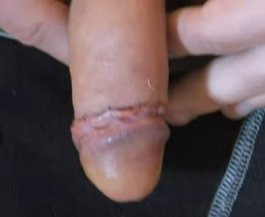
He is told that his foreskin is terribly scarred and damaged and so a circumcision is essential. (We are not shown an image of pre-op penis.) Various friends and medical staff tell him not to worry, but of course he does. Will it be painful? When he comes round after the op there is no pain but of course he is still numb. Eventually the time comes when he has to soak the dressing in salt water and remove it. Here we get various comedic suspense devices before the camera finally pans down and shows the result - a very nice low and tight circumcision.
We get several vignettes after this including one in bed which hints that he is masturbating, and several at an amusement park (one hopes not too soon after the op), presumably to show he is enjoying his new state.
Daniel Jeffery seems to have gone on to a career as a film maker. You can watch the film on YouTube (login may be required as proof of age - seems to be random) or Vimeo.
Review by JH & JB
El Topo, 1970
A psychedelic, surrealistic, Mexican Western.
Directed and produced by Alejandro Jodorowsky (aka Alexandro Jodorowsky), Starring: Alejandro Jodorowsky, Brontis Jodorowsky, José Legarreta. Script and score by Alejandro Jodorowsky.
 El Topo "The Mole" (Alejandro Jodorowsky) is traveling through a desert on horseback with his naked young son known only as Hijo (son), Brontis Jodorowsky, his real life son, who, as we can see, is circumcised.
El Topo "The Mole" (Alejandro Jodorowsky) is traveling through a desert on horseback with his naked young son known only as Hijo (son), Brontis Jodorowsky, his real life son, who, as we can see, is circumcised.
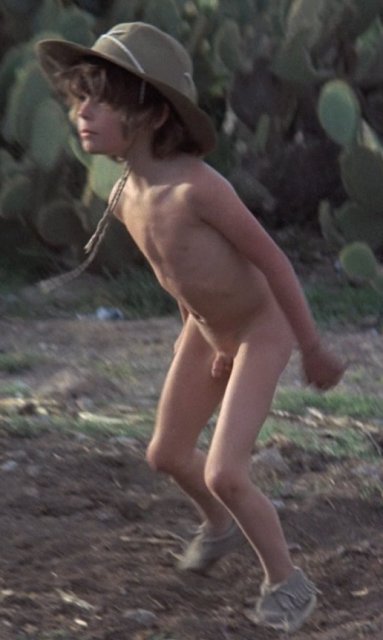
They come across a town whose inhabitants have been slaughtered, and El Topo hunts down and kills the perpetrators and their leader, a fat balding Colonel. El Topo abandons his son to the monks of the settlement's mission and rides off with a woman whom the Colonel had kept as a slave.
El Topo names the woman Mara, and she convinces him to defeat four great gun masters to become the greatest gunman in the land and to earn her love. Each gun master represents a particular religion or philosophy, and El Topo learns from each of them before instigating a duel. El Topo is victorious each time, not through superior skill but through trickery or luck.
After the first duel, a black-clad woman with a male voice finds the couple and guides them to the remaining gun masters. As he kills each master, El Topo has increasing doubts about his mission, but Mara persuades him to continue. After the final gun master outsmarts El Topo by killing himself before El Topo is able to kill him, El Topo becomes ridden with guilt, destroys his own gun and revisits the places where he killed the masters, finding their graves swarming with bees. The unnamed woman confronts El Topo and shoots him several times in the manner of stigmata. Mara then betrays him and rides off with the woman, while El Topo collapses and is carried away by a group of dwarfs and mutants.
El Topo awakens many years later in a cave to find that the tribe of deformed outcasts have taken care of him and come to regard him as a God-like figure while he has been asleep and meditating on the gun masters' "four lessons". The outcasts dwell in a system of caves which have been blocked in — the only exit is out of their reach due to their deformities. When El Topo awakens, he is "born again" and decides to help the outcasts escape. He is able to reach the exit and, together with a dwarf girl who becomes his lover, performs for the depraved cultists of the neighboring town to raise money for dynamite to assist in digging a tunnel on one side of the mountain where the outcasts have effectively been kept imprisoned.
Hijo, now a young monk, arrives in the town to be the new priest, but is disgusted by the perverted form of religion the cultists practice – notably symbolized by the frequent display of a basic line drawing of the Eye of Providence – and their violent preoccupation with guns, from their church "ritual" through to the film's bloody climax. Despite El Topo's great change in appearance, Hijo recognizes him and intends to kill him on the spot, but agrees to wait until he has succeeded in freeing the outcasts. Now wearing his father's black gunfighter clothes, Hijo grows impatient at the time the project is taking, and begins to work alongside El Topo to hasten the moment when he will kill him. At the point when Hijo is ready to give up on finishing the tunnel, El Topo breaks through into the cave. The tunnel has been completed, but Hijo finds that he cannot bring himself to kill his father.
The outcasts come streaming out, but as they enter the town, they are shot down by the cultists. El Topo helplessly witnesses the community being slaughtered and is shot himself. Powering through his wounds, he massacres the town, then takes an oil lamp and immolates himself. His lover gives birth at the same time, and she and his son make a grave for his remains. This becomes a beehive like the gun masters' graves.
El Topo's son rides off with his father's lover and child on horseback.
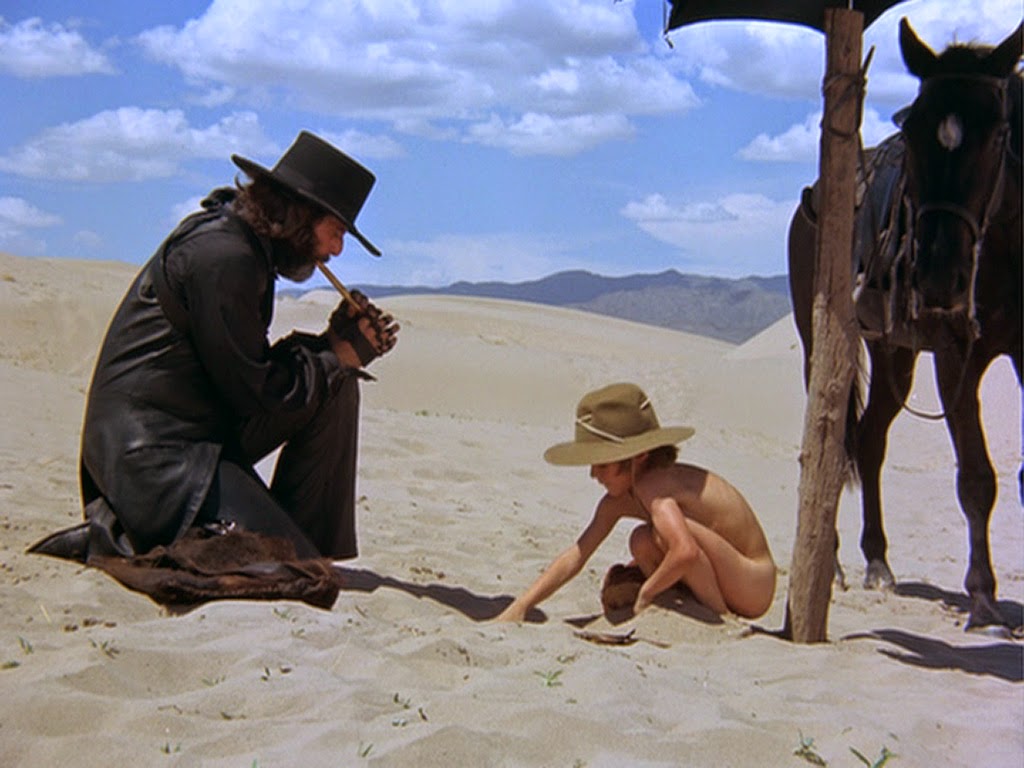
Review by LASM
Available on DVD and Blu-Ray from the usual sources, or online at the Internet Archive.
Editor's note. Jodorowsky very much regarded himself as one of the Surrealists, being in touch with André Breton and Salvador Dali. You can read a very revealing article in the Daily Telegraph. The film did not have general distribution but thanks to support from John Lennon and Yoko Ono had a very successful run in late-hight cinema and recouped many times its cost.
Robby
Directed by Ralph C. Bluemke, Produced by Stacey Enyeart. Starring Warren Raum as Robby, Ryp Siani as Friday,
John Garces as Hank. (The only characters in the film). Award Films International, 1968. Running time 60 minutes
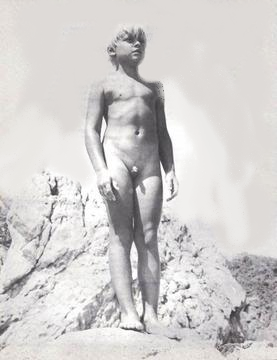
I came across this film quite by accident. It could only have been made in the 60s. A family film that involves nude boys - and why not? Totally innocent, but tell that to our censors today.
The film starts with a lifeboat washed up on a deserted shore. In it is 9-year-old Robby, in T-shirt, shorts and life jacket. He is, as one could imagine, distraught, and runs up and down the beach looking for his parents, and crying. We hear a flashback where they are saying 'get him into the boat'. But he finds nobody, and thinks he is totally alone. He pulls the boat further up the beach, throws some palm branches in to make a makeshift bed, and goes to sleep.
He wakes to find that some food and water has been placed at the back of the boat. This leads him to meet a 10-year-old native boy who, naturally, becomes his friend. The boy's name is something like 'Szanh' but Robby can't manage that and calls him Friday. (The reference is now obvious). Friday has somehow (this is never really explained) been abandoned on the island.
Produnction still of Warren Raum as Robby, from the original publicity for the movie. Courtesy Award Films, via Wikipedia.
The boys' life is now totally together but there is one amusing aspect. Friday has always gone naked but Robby isn't sure about this and turns his T-shirt into a loin-cloth for Friday. From then on we sometimes see them totally naked, sometimes minimally covered. It is clear that Robby is circumcised but Friday is not. This is, I suppose, a cultural divide but the point isn't laboured. Frontal views are minimal.
I don't want to provide a spoiler since the movie is very enjoyable and deserves to reveal its own plot. But of course a family movie has to end happily and in this case there is an amusing twist.
It seems to have gone from Daily Motion but you can find it at Videa or Veoh.The quality isn't great but it's free. Or you can buy it on DVD.
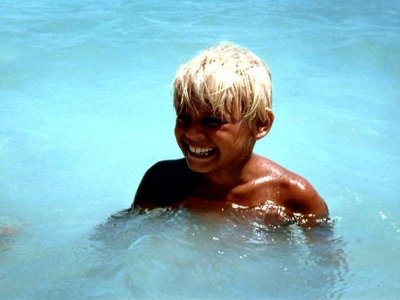 | 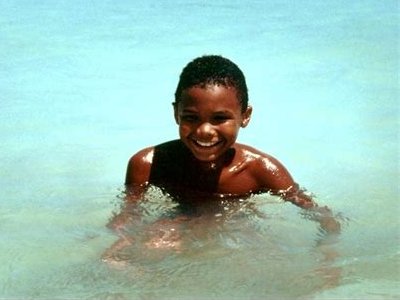 |
| Warren Raum as Robby | Ryp Siani as Friday |
Wikipedia has a substantial article about Robby (but watch the movie first - the article is a bit of a spoiler). The movie was shot on Vieques Island, Puerto Rico, which had previously been the setting for Lord of the Flies. The wildlife shots were obviously not taken there, though (no lemurs in Puerto Rico). Apparently director Bluemke told cameraman Al Mozell to shoot the boys exactly as he would is they were clothed, which Mozell was reluctant to do. In fact he didn't (or maybe the shots ended up on the cutting-room floor) but even so there was sufficient frontal nudity to upset the big cinema chains, and the film had only a limited release. That was sad, because the reviews of the premiere were glowing.
JB
When Father Was Away on Business
(Serbo-Croatian: Otac na sluzbenom putu is a 1985 Yugoslav film by director Emir Kusturica. The screenplay was written by the Bosnian dramatist Abdulah Sidran. Its subtitle is A Historical Love Film and it was produced by Centar Film and Forum, production companies based in Sarajevo.
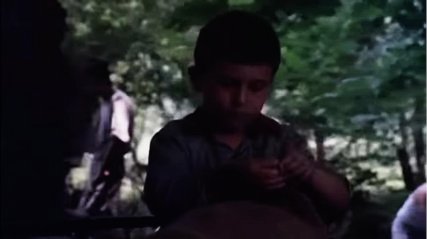
Set in post-World War II Yugoslavia during the Informbiro period, the film tells the story through the eyes of the young boy Malik. His father, communist functionary Mesa (played by Miki Manojlović), has been sent to a labour camp by his own brother-in-law (his wife Sena's brother) Zijo, who's an even higher positioned Communist functionary, for making a remark about a political cartoon regarding the Tito-Stalin Split in the Politika newspaper. Malik is told by his mother that his father was away on business. Before his father leaves, young Malik is circumcised in accordance with Bosniak Muslim customs. There is graphic presentation of the circumcision, (but not the actul cut) at 30:00 into the movie. See the full movie on YouTube here: Sadly, no subtitles.
Emir Kusturica, born 24 November 1954, is a Bosnian Serb filmmaker, actor and musician who been recognized for several internationally acclaimed feature films, as well as his projects in town-building. He has twice won the Palme d'Or at Cannes (for When Father Was Away on Business and Underground), as well as being named Commander of the French Ordre des Arts et des Lettres. Born in Sarajevo, Kusturica is from a secular Muslim family, the son of Murat Kusturica, a journalist employed at the Sarajevo's Secretariat of Information, and Senka Numankadić, a court secretary. He was baptized into the Serbain Orthodox Church in 2005, as Nemanja Kusturica. When asked about his conversion, Kusturica explained that his father had been a Communist atheist, and anyhow, Bosnian Muslims spoke Serbian and ethnically, they had been Serbians, and were converted to Islam under the Ottoman rule of the Balkans. It is not known if Kusturica himself was circumcised as a child.
Acknowledgement: Wikipedia
András Jóvágásúfiú
Europa Europa
Directed by Agnieszka Holland, written by Agnieszka Holland & Paul Hengge, starring Marco Hofschneider. A joint German/Polish/French production by CCC Films, in German with English subtitles.
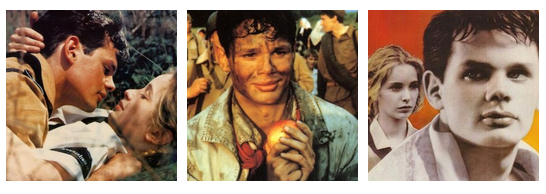
In Germany the film is titled "Hitlerjunge Salomon" (Hitler Youth Solomon). It was scripted in the 1980s, with Marco's brother René intended to play Solomon (Solek). By the time it was filmed in 1990 René was too old and he took the part of Solek's oldest brother Isaak. In 1992 it won the Golden Globe award for Best Foreign Language Film. It was also nominated for an Oscar for Best Adapted Screenplay (won by Silence of the Lambs), but curiously was not entered for Best Foreign Film.
The film is based on the true story of Solomon Perel, played in the movie by Marco Hofschneider. Circumcision is very much a central theme. The movie opens with a flash-back to the young boy’s bris as a new born. The real action starts at his Bar Mitzvah (Jewish coming of age at his 14th birthday). By an unfortunate coincidence this was Kristallnacht, November 9th 1938, when Germans were urged to attack Jewish homes and businesses. When their front door was attacked Solek was in the bath preparing to change into his Bar Mitzvah clothes. He leaps out of the window, naked, and hides in a barrel. When things quieten down he asks a passing female friend (he has lots of these throughout the movie) to get him clothes fron his home. She refuses but gives him a coat with a swastika armband, as good a disguise as any.
Solek returns home, but his sister has been killed and the family decide to quit Germany, returning to their original home in Poland. When the Nazis invade Poland Solek escapes over the border to Russia where he is taken in to a refugee orphanage and educated as a good Communist. All OK until the Germans then invade Russia. Abandoned, Solek approaches the Germans, using a false name, as a fellow German. His fluent Russian (and Polish) are a valuable asset to the troop, and he becomes something of a mascot to them.
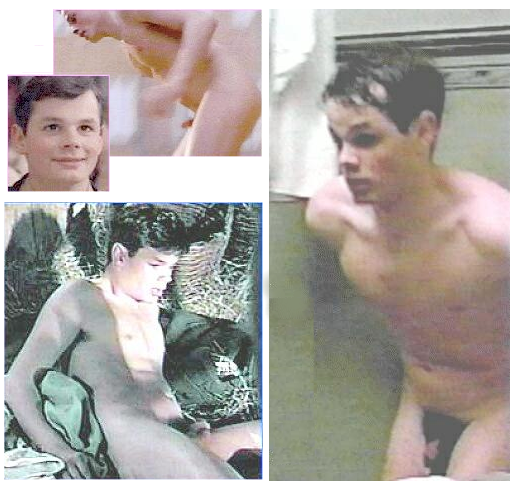
From this point keeping his circumcison status out of sight becomes a matter of life or death, and much of the plot revolves around it. Taking a bath is obviously tricky, but he dosses down in an empty house and finally has the privacy to do so. However a young soldier, Robert, takes the opportunity to creep up and make a homosexual pass at him. He rejects the pass but now they each know the other's secret - both potential death sentences, and they become friends.
Eventually the commander of the unit takes such a shine to "Jupp" that he adopts him as his son and sends him to an elite Hitler Youth Academy in Berlin. (Hence the German title). Needless to say this leads to even more situations where he needs to hide his status, some of which he gets out of by cunning, some by luck. But the Allies are winning, and eventually the Russians move into Berlin. Solek is in trouble - he looks the typical Hitler Youth. He protests that he is a Jew, but the Russians don't want to believe that. He doesn't look like the Jews they've seen. Luckily brother Isaak, just liberated from a concentration camp, is with the Russians and identifies his brother. A happy ending.
The movie ends with the real Solomon Perel, who settled in Israel after the war, singing the words of Psalm 133 to a traditional Jewish melody: "How very good and pleasant it is when kindred live together in unity."
Believe me, I've revealed only a fraction of the twists and turns of this plot, which switches between comedy, tragedy and cliff-hanger. Some of the coincidences are a bit hard to believe - maybe the true story has been embellished. Then again, given how many millions died, maybe it was the tiny few who had such coincidences that survived. The movie is still widely available on DVD, and really is a must-see.
This review is loosely based on one I found in the Circlist archive. That claimed the Marco was in fact not circumcised and wore a prosthesis to make him look cut. I can find no evidence to confirm this and it frankly seems ridiculous. Why would they cast an uncircumcised boy in the part? Other sources say that the Hofschneider brothers are Jewish, which again I can't confirm but it makes more sense than the prosthesis story.
The film has recently been re-released by Criterion on Blu-Ray, with additional interviews. However it is region coded and only available for the UK and North America (why?).
J. B.
Jessica Yatrovsky - I <3 Boys (I 'heart' boys)
Introduction: East Village Boys by Weston Bingham.
Power House Books, Brooklyn, NY. 2011 Unpaginated. (approx 100 pages) ISBN 978-1-57687-569-8 Hardcover, $US 24.95
The boys Jessica Latrovsky 'hearts' are young men aged (I'm guessing) from 18 to 25. They are absolutely not macho men, on the contrary they are quite androgynous, with few having any body hair. We are told nothing - there is no text from the photographer and the pages aren't even numbered. Without Bingham's introduction we wouldn't even know that they came from the East Village area of New York. Otherwise Bingham's introduction just says what I have said above, at greater length. We do know the boy's names - listed at the end with no indication of who is who.
Are they gay? Well, some are in clinches which strongly suggests that they are, but that doesn't seem to be the point. The point is that these young men are beautiful. Clearly they don't all (or any?) stick to stereotyped gender roles, but that is just part of the picture, and doesn't preclude heterosexuality as an equally valid alternative. Yatrovsky's website hints (but doesn't state) that she is gay, and she has a successor book "I <3 Girls" due out shortly (as of November 2015). This, it seems, will pursue the issue of androgyny from the other side of the fence.
The one thing that these beautiful young men have in common is that they are all circumcised. A wide range of styles, but it's a foreskin-free zone. For most Circlist readers, straight or gay, this book will be a feast for the eyes and well worth its very modest cost.

One of the opening images of the book - three nude boys with a clothed girl. Is she Jessica Yatrofsky? Of course we are not told, but one could suspect ...
Footnote - regular female correspondent MG has pointed out that in a higher resolution version of this image the boy second from left actually has a foreskin! You can see the image here. I think this is the only foreskin in a 99% foreskin free zone.
JB
Gian Paolo Barbieri - Exotic Nudes
Taschen, December 2002, 288 pages ISBN 10: 3822823422 ISBN 13: 9783822823422 Available in several languages.
This is in fact two books in one, Equator - sun, sea and sex in the Seychelles, first published in 19990, and Tahiti Tatoos, first published 1998. The overall title is a bit of a misnomer, it is absolutely not all nudes but it is all fabulous photography. In Equator we see a lot of marine life, and the people who catch them. We also see exotic fruit, often paired with matching nudes. Some are obvious, such as the legendary double coconut paired with a woman's bottom. Others less so.
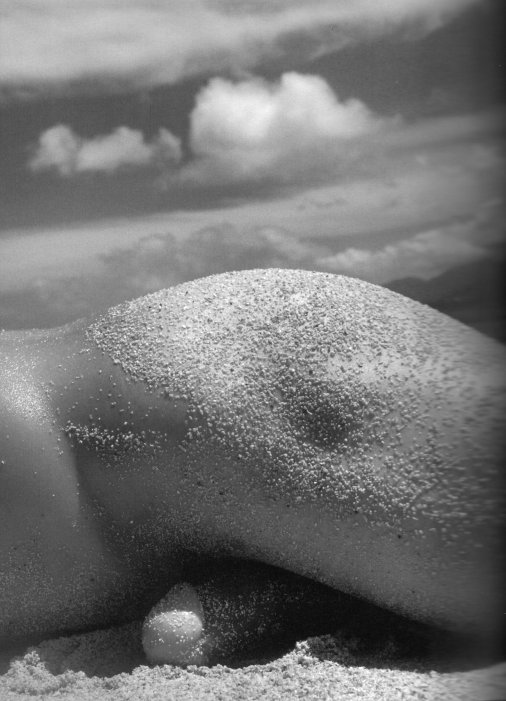 | 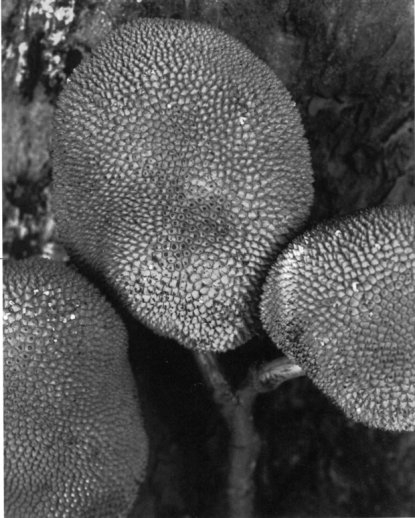 |
JB
Women see Men
Edited by Yvonne Kalmus, Rikki Ripp and Cheryl Wiesenfeld. Introduction and text by Ingrid Bengis
McGraw Hill Book Company, New York 1977 ISBN 0-07-033248-7
“Throughout photographic history …. nude almost always meant women, model almost always meant female ….” say the editors on the dust-jacket, and this book set out to reverse this situation. This was, of course, well before Sally Mann’s tender pictures of husband Larry and son Emmett in “Immediate Family”, and even longer before Jessica Yatrovsky’s “I <3 Boys” (reviewed here). In spite of these words, the photos are not all nudes – far from it. Men are pictured in all sorts of situations, and some of the portrayals are far from flattering. Some are just amusing, like Naomi Bushman’s cover photo of a man pulling his t-shirt off. The only flesh we see is his torso since his head is inside the shirt. Looking through the open window behind him is a clothed, older woman while below the window is a mirror in which we see the photographer, nude, taking the picture.
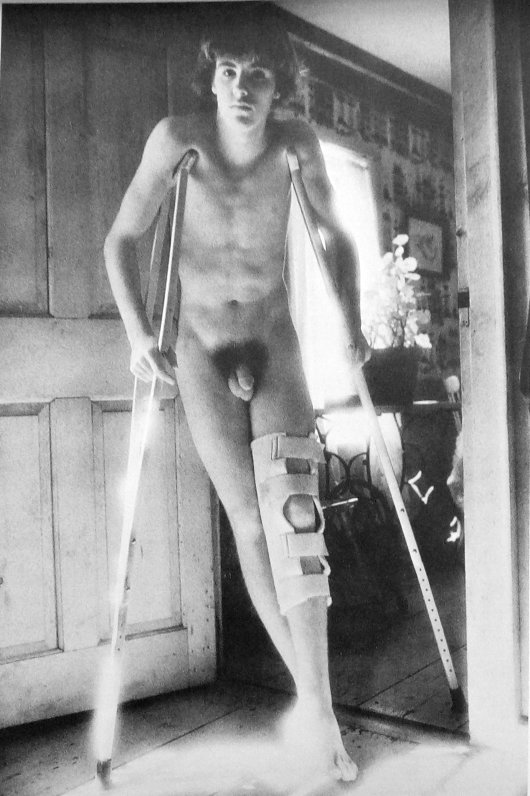
The choice of Ingrid Bengis to provide the minimal text is a bit strange since, to put it mildly, she seems to have a problem with men. She writes “The challenge of making the effort to ‘see’ men is that they have the habit of concealment, a reserve so profound that it scarcely leaves any suspicious traces.” This is absolute nonsense – a man may not be good at verbalizing his feelings but he is hopeless at concealing them in his face, as the photographs in this book show all too well. Women, on the other hand, can often put on a perfect mask, as Bengis tacitly concedes when she follows up this statement with “A woman’s face in repose tends to be expressive of some element in her inner life, which she might not choose to reveal otherwise.” (My italics).
Some explanation may come from her introduction to the section on men with babies and children – one of the best parts of the book. “She once said that seeing a man play with is children always made her cry. Her husband had never done it with their children; her father had never done it with her.” ‘She’ here is presumably Bengis and, frankly, the thought of such emotional deprivation makes me want to cry, too. But Bengis was going around University campuses lecturing on male-female relationships! For the record, in my long life, I’ve never encountered a father who didn’t join in his children’s play.
A lovely photograph in this part of the book is Jacquelin Poitier’s “Dancer and baby” - a ballet dancer cradling his baby on his knees. He looks a lot like Rudolf Nureyev but obviously isn’t since Nureyev was gay. But my favourite in this section is Sylvia Plachy’s “Kite Flying, Long Island” where the adults are fussing about assembling the kite while the young boy, for whom it is supposed to be all about, is totally excluded and looks utterly pissed off. Sadly I can’t reproduce it here since it straddles two pages.
Untitled photograph by Starr Okenga. Right click and select 'view image' to see full size.
Some of the photos are of famous men, including Man Ray, a famous portrayer of sensuous female nudes. Others include Norman Mailer, in a suitable macho pose, Fritz Lang the legendary silent film director, Marcel Duchamp the avant-garde artist and documentary photographer Bill Brandt. None of them are naked. But there are naked men, including a muscular (and circumcised) dwarf and many others. I’m showing here another favourite, Starr Okenga’s untitled picture of a teen with an injured knee. Younger boys feature too, mostly clothed though Joanne Leonard shows two pictures of Benjamin Rubin – nude at age two, and lying on a bed in jeans and boots at age 9 (on a bed with boots would be big trouble in our household). He is circumcised, but then his name suggests that he is Jewish. Actually, all the nude males shown in sufficient detail seem to be circumcised, perhaps not surprising given the American origin of this book (all the photographers reside in the US).
The book is out of print but widely available on the second-hand market. Thanks to JH for bringing it to my attention.
JB
Twelve - a day in the life of a boy
by Frederick Secord, edited by Georges St Martin
Book Adventures, New York 1966 Library of Congress catalog number 66-29089
Georges St Martin and Book Adventures are the people who gave us the best-selling coffee table book "The Boy, a Photographic Essay", and its even more lavish, but less commercially ssuccessful, follow-up "Boys will be Boys". This is in the same vein, but with just one boy (and sometimes a friend) and one photographer. There is a brief introduction, then it's all pictures.
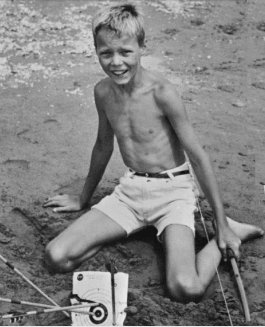
"Twelve is a wonderful age - the last year of true childhood. .... Not yet bewildered by his adolescence, indeed unaware of its imminence, he is comfortable with his proven abilities, ... secure and confident. Old enough to be more independent than before, young enough to enter unselfconsciously into the world of imagination, the twelve year old is at the peak of his childhood." Well, I can go along with some of this and won't deny that twelve is a great age, but as someone who was once a boy, and the father of two sons, I can say that at twelve a boy is all too aware of the imminence of adolescence.
Matt is the son of an American mining engineer working in Peru. The theme of the book is his ability to straddle the two worlds of American and Peruvian culture. The book takes the highlights of a summer and presents it as a single (admittedly impossible) day from Matt getting up on the morning to going to bed at night. We see him in the streets of Lima, eating the great foods on offer from street vendors, climbing on an antique steam engine, down on the beach, but also in the mountains. He plays at archery with a Peruvian friend, as we see here, but we also see him playing golf, of all things. At the start he is wearing trousers, shirt and tie (school uniform, I suppose) but mostly he's in more casual wear - shorts or jeans. He wears a hoodie in some pictures, which you certainly wouldn't in summer in Lima, but then here he is in the mountains.
It seems that his favourite attire is just shorts, as we see here, since when we see him naked on the beach with his Peruvian friend he has a tremendous tan everywhere except where his shorts cover. His friend, with a darker skin, is one colour all over. Here we see another cultural difference since Matt is circumcised and his friend isn't. We also see that Matt, and his friend, are clearly not twelve since both are at Tanner stage 1. (See our page on Tanner stages.) Stage 1 is described as "Juvenile. Age range 0-14, but typically up to age 9. Testicle volume less than 1.5 ml, penis 1-3 cm in length. No pubic hair" and this fits both boys. OK, one boy could be a late developer, but both? So why wasn't the book called "Ten"? That's a pretty fun age too!
The book is out of print and copies are hard to find but you may well find it in a library. Our review copy came from the University of Arkansas library.
JB & JH
History of Circumcision from the Earliest Times to the Present.
Moral and Physical Reasons for its Performance, with a History of Eunuchism, Hermaphrodism, Etc., and of the Different Operations Practiced Upon the Prepuce
Peter Charles Remondino, MD. The P.A. Davis Co., Philadelphia, 1891 (several modern reprints are available)
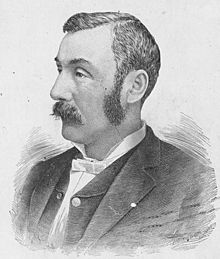
This is the book that is widely credited with popularising circumcision in the USA. In spite of its title it is much more than an historical book. There is a discussion about it in our USA page. The whole book is available online through Project Gutenberg - you can access it here.
As his name suggests, Remondino was born in Italy. His family emigrated to the US when he was 8, at which time he presumably anglicised his Christian names. He trained as a doctor and served with distinction as a military doctor in both the American Civil War and the Franco-Prussian War. He subsequently settled down as a highly respected medical practioner in San Diego, California. (Image, right, and biographical details, courtesy Wikipedia.)
It must be said that the book is rather eccentric. In the historical part we have chapters on 'Antiquity of Circumcision', 'Theories as to the Origins of Circumcision' and 'Spread of Circumcision'. In the 18th and 19th centuries debate around the origins of circumcision was essentially about whether the Jews or the Egyptians introduced it first. Remondimo comes down on the side of the Jews, and suggests that it spread from there to the Americas (and presumably Australia, since he discusses Australian customs). A quite extraordinary ignorance of history. He goes on to discuss various topics such as male and female infibulation, and attempts to abolish circumcision.
Chapter 7 is about miracles and the Holy Prepuce - see our news item of 18th December 2019. This is really huge fun - and was obviously intended to be. It is quite clear that Remondino never intended his book to be a dry as dust historico-medical tract. 8 and 9 are about castration and eunuchs, 10 is about hypospadias and intersex. Then we get chapters on the Jewish practice including the horrible and dangerous rite of metzitzah (sucking the baby's penis).
Now, at this point Remondino seems to have covered all the ground of his lengthy title, but he is only at page 160 of 335. The rest of the book takes us to his real message, the medical benefits of circumcision. And in his view they are extreme. Jews, for example, apparently have an immunity to consumption (tuberculosis) which he ascribes to circumcision. He is on safer ground with sexually transmitted diseases and cancer. And he is waging war on every shape and size of foreskin.
It is not alone the tight-constricted, glans-deforming, onanism-producing, cancer-generating prepuce that is the particular variety of prepuce that is at the bottom of the ills and ailments, local or constitutional, that may affect men through its presence. The loose, pendulous prepuce, or even the prepuce in the evolutionary stage of disappearance, that only loosely covers one-half of the glans, is as dangerous as his long and constricted counterpart.In spite of this, in the actual cases he quotes there was usually a long and constricted or attached foreskin. Nervous diseases, systemic diseases - all of these could be attributed to the prepuce. Masturbation only gets a few passing mentions and Remondino seems to regard it as solely caused by a restrictive prepuce.
What makes this book fun to read are the anecdotes, from his own and other physician's practices, peppered through all the chapters. These are often hilarious, such as the man who presented with a 'rather dilapidated prepuce' through which the man's wife had fitted two little golden padlocks to stop him straying. Or the man who, convinced of the behefits of circumcision, decided to do it himself with kitchen scissors in the woodshed. He only succeeded in getting his foreskin trapped between the blades of the scissors, and was then dancing around like a madman, not letting anyone touch him for fear he would lose his manhood. Eventually he was persuaded to let a doctor remove the scissors and his bruised foreskin recovered. It seems he gave up the idea of getting circumcised. There are many such anecdotes, some which strain credibility, and I'm sure they are why the book has remained popular.
JB
Circumcision in Man and Woman
Its History, Psychology and Ethnology
Felix Bryk translated by David Berger. American Ethnological Press, New York, 1934. Originally published in German, Beschneidung bei Mann und Weib, Gustav Feller. New Brandenburg, 1931. English edition reprinted AMS Press, Inc, New York, 1974 ISBN 0-404-57420-3.
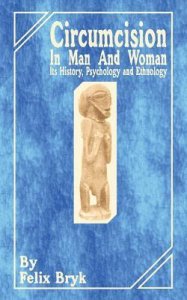
Any student of circumcision needs to get a copy of this book, it's a classic - but one shouldn't take it too seriously. Felix Bryk was born in Vienna in 1882 and his major career was as a lepidopterist. He has several new butterfly species descriptions to his credit. He spent much of his life in Scandinavia - he was in Helsinki when this book was published and died in Sweden, but all his published work is in German. In 1928 he published a book about sexual customs in Kenya, presumably observed while he was there collecting butterflies. The German title was 'Neger-Eros', which I would translate as 'Negro Eros' but the English translation appeared with the somewhat sensational title 'Voodoo-Eros'. (A later translation, by a different hand, rendered it as 'Dark rapture : the sex-life of the African Negro'). It is kind of obvious that the aim was more titillation than scientific anthropology.
Clearly sex sold better than butterflies. And given that in Kenya circumcision was a major factor in sexual behaviour, Bryk seems to have decided that it would be the focus of his next anthropological book. This book is mostly not based on his own observations (though it includes them) but on an extremely wide literature survey. Wide, but somewhat uncritical. He gives extensive credence to the writings of 'Jacobus X', a French doctor working in Asia, whose stories are generally discredited. Nevertheless, the sheer scope of his work makes it well worth reading. And, like Remondino, it is an entertaining read. His illustrations are mostly taken from his sources and so rather poor quality, and won't stand further reproduction.
You thought that Kellog coined the idea that circumcision prevented masturbation? Sachtleben, in 1792, is quoted as saying "Circumcision is probably ... the most effective of all means (of preventing masturbation). The pain involved in the onanism or manustupration of those who are circumcised is much too severe not to outweigh the pleasure combined with the act." Not that Bryk was buying that - as he pointed out the Jewish Talmud prohibited masturbation which would hardly be necessary if it wasn't possible. But he also sought out practical evidence.
....the same is true of the Islamitc Indians, among whom it is call jalakh and is usually performed by plucking the frenulum about until the orgasm sets in, which circumcised Arians also do in Europe. Also a circumcised negro (Sebeyi) masturbated in my presence.So jalakhing off!
There is a huge amount of information in this book, it just needs to be read critically. Get your hands on a copy. There are various later editions including 'print on demand' options. Extensive extracts from Circumcision in Man and Woman, and a short one from Neger-Eros (here translated as African Eros) can be found on Robin Stuart's Male initiation site.
JB
Foreskin Man
Online comic by Matthew Hess.
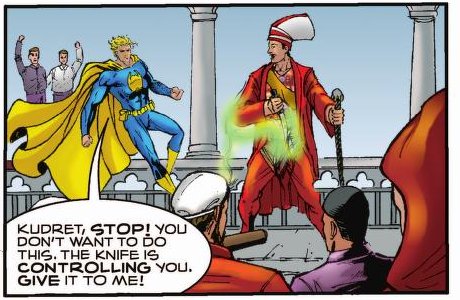
Reader Harry sent in this link. He writes " Foreskin man was a comic book drawn by Matthew Hess that ran online for 7 issues a few years ago. Foreskin Man was a superhero who saved innocent foreskins from the knife. The villainous circumcisers were often if not usually some the worst racial and ethnic stereotypes I've ever seen. "
It really is hilarious, and incredibly politically incorrect. Base story: Miles Hatwick is a former corporate scientist who now heads the "Museum of Genital Integrity" on a small island off the coast of San Diego, Ca. Unbeknownst to the public, Miles is also Foreskin Man, an intactivist superhero who rescues innocent boys from the clutches of the world's cleverest and most dangerous circumcisers. There are voluptouos females in every issue, and sometimes quite explicit sex, which you won't find in Marvel comics! Also, while Clark Kent just changes his clothes and ditches his glasses to become Superman, Miles somehow loses his beard! It is so over the top that I sometimes wonder if it is a deliberate parody, but then, intactivists are not known for having a sense of humour, nor of irony.
The publisher is given as MGMbill - nothing to do with Metro-Goldwyn-Mayer, an attempt to persuade Congress to pass a bill banning 'male genital mutilation', which of course went nowhere. Once again it was totally over the top, seeking to also ban childhood foreskin retraction! Can you imagine this classroom exchange:
"Teacher, I saw Johnny pull his foreskin back when he went to the bathroom at lunnchtime."
"Thank you George. John, we cannot tolerate this sort of behaviout. I'm calling the police immediately."
It really does read more like an art-student stunt, but Hess is certainly a talented artist.
Access the seven issues (and some trading cards!!) at MGMbill or at the Internet Archive
Harry & JB

